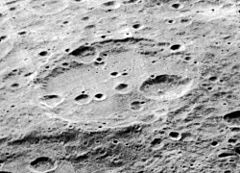Rowland (crater)
 Clementine mosaic | |
| Coordinates | 57°24′N 162°30′W / 57.4°N 162.5°W |
|---|---|
| Diameter | 171 km |
| Depth | Unknown |
| Colongitude | 163° at sunrise |
| Eponym | Henry A. Rowland |


Rowland is a large lunar impact crater that is located in the northern part of the Moon, on the far side from the Earth. This is an old, worn formation that is overlain by a number of smaller craters. The most notable of these is Rowland Y, which is attached to the inner wall along the north-northwestern rim. Additional smaller craters are attached to the inner wall along the southeastern and south-southwestern rims, the latter being designated Rowland N. Rowland C forms a double crater with a smaller, bowl-shaped formation in the eastern part of the floor.
The outer wall of Rowland has been rounded by a long history of minor impacts, leaving the edge somewhat irregular and rough. The top of the rim has been worn down until it became almost level with the surrounding terrain, making this a circular depression in the surface. The remains of a terrace can still be discerned in places, particularly along the eastern and southeastern inner wall.
Attached to the exterior of the eastern rim is the huge walled plain Birkhoff, an even older and more worn formation. Due north of Rowland, within one crater diameter, is Sommerfeld. To the west-southwest is the smaller crater Chappell.
Satellite craters
By convention these features are identified on lunar maps by placing the letter on the side of the crater midpoint that is closest to Rowland.
| Rowland | Latitude | Longitude | Diameter |
|---|---|---|---|
| G | 57.0° N | 159.4° W | 18 km |
| J | 53.1° N | 155.5° W | 49 km |
| K | 51.4° N | 157.1° W | 25 km |
| M | 51.9° N | 162.4° W | 58 km |
| N | 55.4° N | 163.7° W | 30 km |
| R | 53.7° N | 169.5° W | 24 km |
| Y | 59.1° N | 163.0° W | 54 km |
The area south of Rowland R is characterised by an extremely high rockfall density by lunar standards.[1]: 2, 3
References
- Andersson, L. E.; Whitaker, E. A. (1982). NASA Catalogue of Lunar Nomenclature. NASA RP-1097.
- Blue, Jennifer (July 25, 2007). "Gazetteer of Planetary Nomenclature". USGS. Retrieved 2007-08-05.
- Bussey, B.; Spudis, P. (2004). The Clementine Atlas of the Moon. New York: Cambridge University Press. ISBN 978-0-521-81528-4.
- Cocks, Elijah E.; Cocks, Josiah C. (1995). Who's Who on the Moon: A Biographical Dictionary of Lunar Nomenclature. Tudor Publishers. ISBN 978-0-936389-27-1.
- McDowell, Jonathan (July 15, 2007). "Lunar Nomenclature". Jonathan's Space Report. Retrieved 2007-10-24.
- Menzel, D. H.; Minnaert, M.; Levin, B.; Dollfus, A.; Bell, B. (1971). "Report on Lunar Nomenclature by the Working Group of Commission 17 of the IAU". Space Science Reviews. 12 (2): 136–186. Bibcode:1971SSRv...12..136M. doi:10.1007/BF00171763. S2CID 122125855.
- Moore, Patrick (2001). On the Moon. Sterling Publishing Co. ISBN 978-0-304-35469-6.
- Price, Fred W. (1988). The Moon Observer's Handbook. Cambridge University Press. ISBN 978-0-521-33500-3.
- Rükl, Antonín (1990). Atlas of the Moon. Kalmbach Books. ISBN 978-0-913135-17-4.
- Webb, Rev. T. W. (1962). Celestial Objects for Common Telescopes (6th revised ed.). Dover. ISBN 978-0-486-20917-3.
- Whitaker, Ewen A. (1999). Mapping and Naming the Moon. Cambridge University Press. ISBN 978-0-521-62248-6.
- Wlasuk, Peter T. (2000). Observing the Moon. Springer. ISBN 978-1-85233-193-1.
- ^ Bickel, Valentin Tertius; et al. (2020-06-08). "Impacts drive lunar rockfalls over billions of years". Nature Communications. 11: 1–7. doi:10.1038/s41467-020-16653-3. eISSN 2041-1723. PMC 7280507.
